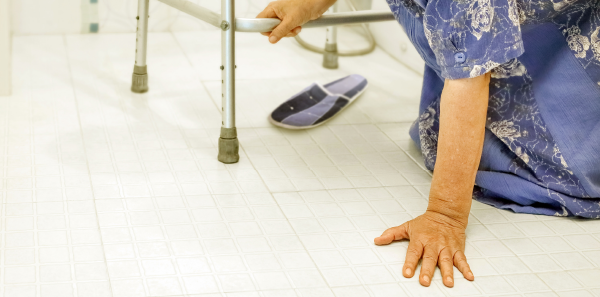
The cost of patient falls in elderly persons is expected to reach $32.4 billion dollars in 2020.1 Patients fall most often in their bedrooms, followed by the bathroom; this holds true both at home and in the hospital. Fortunately, a growing body of research surrounding falls in the hospital helps us understand some of the conditions and circumstances that contribute to falls.
Explore This Issue
ACEP Now: Vol 37 – No 10 – October 2018Identify and Communicate
Process and design changes exist that can reduce the risk of falls for emergency department patients. One important process change is identifying patients who are fall risks; checklists at intake can help identify them. Risk factors for falling include:
- History of recent falls
- Decreased level of consciousness
- Use of a walking aid
- Difficulty rising from a chair
- Balance problems
- Hypotension/orthostasis
- Presence of:
- Foley catheter
- Brace or cast
- Feeding tube
- IV or heparin lock
- Certain diseases such as stroke, seizures, or Parkinson’s
- Taking three or more medications
- Visual or hearing impairment
Once falling risk factors have been identified, how do you effectively communicate that information to all members of the emergency department team? Noting the patient is a fall risk in the chart has become commonplace, and using more visual cues is gaining momentum. Some organizations use color-coded booties (typically red), and these booties often include nonskid design elements. These brightly colored booties are readily identifiable by staff, including transport techs, radiology techs, and ED techs, who may have only brief encounters with the patient and inadvertently put the patient at risk. Commercial products such as the Patient Care Sign allow staff to use sign icons on the patient door such as Fall Risk, NPO, Isolation, etc.
The point: Identification alone will not reduce falls if the risk is not conveyed to staff and there are not policies and procedures in place to reduce the risk.
Design Changes
So what are some of the procedures and policies that have become part of effective fall-reduction programs? Use of a low-rise bed, easy access to call lights, nonskid slippers or floor mats, alarm mats that chime when the patient gets out of bed, and decreased clutter in patient rooms all can reduce falls.
Other design features have demonstrated potential for reducing falls as well. Slippery floors (the proverbial polished linoleum) contribute to falls, and there is much experimentation afoot using antibacterial carpet tiles with nonskid surfaces. Adding floor lighting to improve visibility for visually impaired patients and installing adequate railings can improve safety in clinical areas.
The direction a bathroom door opens can increase or decrease patient falls. When the door opens into the bathroom, the patient becomes crowded into the sink or commode and can fall, so it is best for the restroom door to swing outward. In some new modular designs, the commode folds down from the wall right next to the patient’s bedside so the patient does not travel far. New room designs include a family space to encourage family members to monitor their loved ones for safety.
The height of furniture, especially beds and toilets, can be tricky. You will often read that these should be low for ill patients, but that is not entirely correct. Research from the Center for Health Design suggests beds and toilets be high so that patients, whose limb girdle muscles are the first to weaken during illness, do not have to lower themselves a long way down to the furniture. On the other hand, lower beds and commodes are associated with less severe injuries when the patient does fall.
A final design change associated with decreasing fall rates is one still not widely popular with nurses: decentralized nurse stations. Clinical units are being designed with work stations scattered throughout the department to allow nurses more opportunity to do paperwork while observing patients. Decentralization offers other advantages, too, including decreased noise levels, which is critical to patient satisfaction, and decreased amounts of walking for nurses who have to work from multiple sites.
The Potential
How much can these kinds of process and design changes reduce falls? The Center for Health Design estimates design changes alone can reduce patient falls by as much as 17 percent. Methodist Hospital in Indianapolis, Indiana, ramped up its fall-reduction program with rigorous procedures and design changes that included a family space in every patient room and decentralized nurse stations. These efforts resulted in a reduction of patient falls from six per 1,000 patients to two per 1,000 patients in a cardiac care unit.2
As many emergency departments consider adding geriatric service lines to their departments, the issue seems even more relevant than in the past. Shouldn’t we apply some of these strategies in the emergency department?
References
- Chang JT, Morton SC, Rubenstein LZ, et al. Interventions for the prevention of falls in older adults: Systematic review and meta-analysis of randomized clinical trials. BMJ. 2004 Mar 20;328(7441):680.
- Hednrich A, Fay J, Sorrells A. Courage to heal: comprehensive cardiac critical care. Healthcare Design website. Accessed September 26, 2018.
Pages: 1 2 3 | Multi-Page






No Responses to “Tips for Reducing Falls in Your ED Via Process and Design Changes”